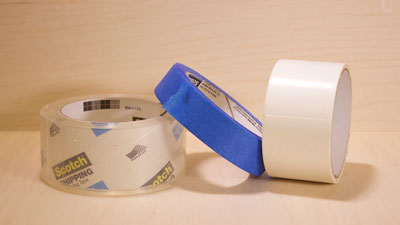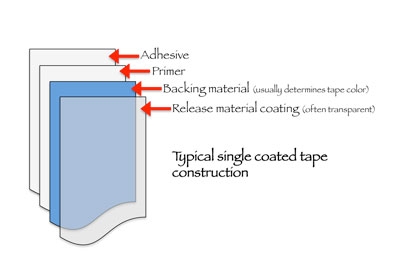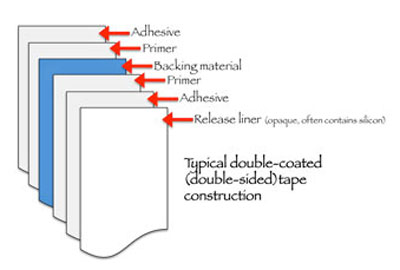
 by Steven D. Johnson
by Steven D. Johnson
Racine, Wisconsin
This month:
•
A Sticky Brand Extension
•
Sins Of Commission, Sins Of Omission
•
The 5S Compliant Shop Wall Cabinet Project
Sticky Brand Extensions
Click on any picture to see a larger version.
You know what a brand extension is… someone makes a product that is a big hit, and then to capitalize on the popularity starts to make variations or even completely different products with the same name. Brand extension explains the 91 varieties of Cheerios (that may be an exaggeration, but not by much), Cheerios snack bars, and Cheerios snack mix, and why Aunt Jemima started with pancake batter, moved on to syrup, light syrup, a line of frozen breakfast foods and more.
It might not be the text book example of brand extension, but as a product that has morphed into literally thousands of sizes, styles, colors, and intended uses, the ubiquitous roll of pressure sensitive adhesive (PSA) tape wins the award as the most diverse line of products based on a single, simple concept… something sticky on a non-sticky backing.
Please don't think my "something sticky" description is demeaning. I would never downplay any industry with $37 Billion in annual worldwide sales. In the U.S. alone, the Pressure Sensitive Tape Council, a not-for-profit trade organization, lists member's manufacturing facilities in 28 states employing over 53,000 people with annual sales of over $11 Billion. These U.S. companies alone make over 3,500 different pressure sensitive, adhesive tape products. And when I say "different" products, I mean "different"… not variations like colors or sizes or packaging, but truly different products. If we included variations, the assortment of different tape products would number in the tens of thousands.
It would be virtually impossible and absolutely frustrating to try to list all the different kinds of tape on the market. Duct tape, electrical tape, masking tape, packing tape, and carpet tape we know. But there are also copper foil conducting tapes, cable tapes, foam tapes, speed tapes, and surgical tapes, which, by the by, is how pressure sensitive tape was invented back in 1845 when Dr. Horace Day applied some rubber adhesive to a cloth backing to make the first surgical tape.
In 1921 Earle Dickson, a cotton buyer with Johnson & Johnson, attached a piece of gauze to a strip of cloth-backed adhesive tape and made what we now know as the BandAid. The company promoted Mr. Dickson to Vice President to reward his accomplishment. Also in the early '20s, nascent carmakers were attaching paper to cars with cloth-backed tape to limit paint overspray, but the paint was leaking through the tape. In 1925, Richard Drew, an engineer with 3M, invented what we know today as "masking tape" to solve the problem. It was the first time paper was used as a backing for adhesive tape. A few years later he got the idea to apply adhesive to clear cellulose, and Scotch Brand Cellulose tape was born. I hope he got a big bonus for his efforts, not merely a new title.
And as long as we are extolling the virtues of some smart brand extensions, with two cats I want to personally thank the genius who had the idea of winding up a roll of tape inside-out and calling it a "lint roller." My house is much more "hair free" than it would be otherwise. Perhaps instead of a "brand extension" we should call this a "brand inversion."

|
|
Figure 3 - The Big Three woodworking tapes: packing,
masking & double-sided
|
We woodworkers are mostly concerned with three types of tape: Packing Tape, Double-Sided Tape, and Masking Tape. Packing Tape, more commonly known as "carton sealing tape," represents two-thirds of global tape sales. Double-Sided Tape, sometimes called carpet tape, was invented for just that reason. And, as mentioned earlier, Masking Tape was created to make for neater paint jobs in the automobile industry and is now used in all kinds of painting applications.
In the workshop, packing tape is a great way to wrap parts tightly together for various milling operations. I use it frequently to re-attach a cutoff piece from a tapered leg so that the work piece can be turned and passed safely again through the saw. We also use it from time to time to close a box for storage or shipping.
Double-sided tape is often used to hold a template to a work piece or to hold two or more work pieces together while performing some shaping or smoothing operation.
Perhaps the tape we woodworkers use most is masking tape. Low adhesion allows masking tape to peel off easily leaving little residue behind (hopefully) and affecting little damage to the surface. We use it for marking parts, temporarily attaching parts, or keeping loose parts together. A strip placed along a cut line will reduce splintering in some specific cutting circumstances and I frequently use a strip of tape as a shim to perfect an angle. Masking tape makes great temporary labels, too. On occasion I have even used the stuff for its original intended purpose… as masking.
Of course most of us have a roll or three of duct tape and perhaps even a few other types of tape cluttering our workshops, but the big three are "masking," "packing," and "double-side." Since there are almost as many ways of rating, ranking, and testing tapes as there are tapes, I decided to look only at the things important to woodworkers. Tensile strength, resistance to stretching, dimensional stability, resistance to liquid, adhesion, and many other factors matter little. What matters most to woodworkers?
-
When I remove the tape will there be any residue left behind?
-
Will any residue be visible? Easy to remove? Will it interfere with my finishes?
-
When I remove the tape will it lift splinters or otherwise damage my work piece?
-
How long can I leave tape on a surface before 1, 2, or 3 above start to impact the tape's usefulness?
-
Tape is expensive… if I find it on sale and buy a bunch, will it "keep?" Is there a meaningful difference between brands?

|
|
Figure 4 - Masking & packing tapes are typically
constructed of 4 layers
|
In order to delve deeper into the tapes we use, we need to understand a little more about how tape is typically constructed. Other than double-sided tape, most of the tape we use consists of four layers. The backing may be of paper (masking tape), plastic (packing tape), or cloth (duct tape). But the backing is not really the "back," as it is usually coated with a release material so the tape can be rolled up and the adhesive will not adhere as strongly to itself. The backing material receives another special coating on its other side before the adhesive layer is applied. This special primer material helps the adhesive stick to the backing more than it will stick to another surface to make sure the adhesive peels away with the backing rather than staying on the surface to which it was applied. The primer also keeps the adhesive from absorbing quickly into the backing (which is fundamental to the aging process of tapes).
Double-sided tape typically has two additional layers: A primer layer between the backing and the additional sticky side and a release paper, usually silicon-coated or similar, that allows the tape to be rolled up for sale, and unrolled for use.

|
|
Figure 5 - Double-sided tape is usually made up of 6 layers
|
While it may not seem so, the adhesive on tape should be thought of as a viscous liquid material. This viscous liquid permeates the pores of material to which it is attached, forming a type of bond. The strength of that bond is determined by a tape property known as "surface energy." All other things being equal, a higher surface energy will mean a stronger bond.
When we apply tape, the adhesive actually flows into pores in the surface we are taping and "keys" into place. This "keying" creates a physical "locking" of the tape to the surface.
The adhesion of tape generally increases over time as the adhesive flows further into the surface to which it is adhered. Some tapes can actually double in adhesive strength after a period of time. In addition to the adhesion strength of tape, there is a measurement known as "cohesion." Cohesion is the ability of the adhesive material to stay intact. When cohesion is higher than adhesion, the tape will peel away cleanly and no adhesive will be left behind. When the adhesion at the surface layer is stronger than the cohesion of the adhesive material itself, removing the tape will split the adhesive and leave a layer behind.
We are all familiar with this phenomenon: A band-aid left on overnight or worn on a hot day may leave tape residue behind when it is removed. And we all know what a surface looks like after duct tape is removed. The longer a tape is left in place, the longer the adhesive can migrate into the pores of the material and the tape will become more difficult to remove. Simply put, when adhesion surpasses cohesion, residue is left when the tape is removed. This explains why some so-called "painter's tapes" provide a time recommendation. You may see these advertised as one-day tapes, seven-day tapes, fourteen-day tapes, etc.
There are many factors that can impact the delicate balancing act between adhesion and cohesion like ambient temperature, surface cleanliness and porosity, humidity and the age of the tape. Even the pressure by which you apply the tape will have an impact on the ratio of adhesion to cohesion.
Next month, we will look at the long term tests I have conducted on adhesion, cohesion, and adhesive residue. We will also learn how to best assure that no adhesive remaining on the surface of our project will interfere with our finishes, how to best store tape, for how long, and when to toss it. In the end, I came up with a list of the three best tapes for woodworkers.
(Page 1 of 3)
1
2
3
Next Page
Return to
Wood News
front page

